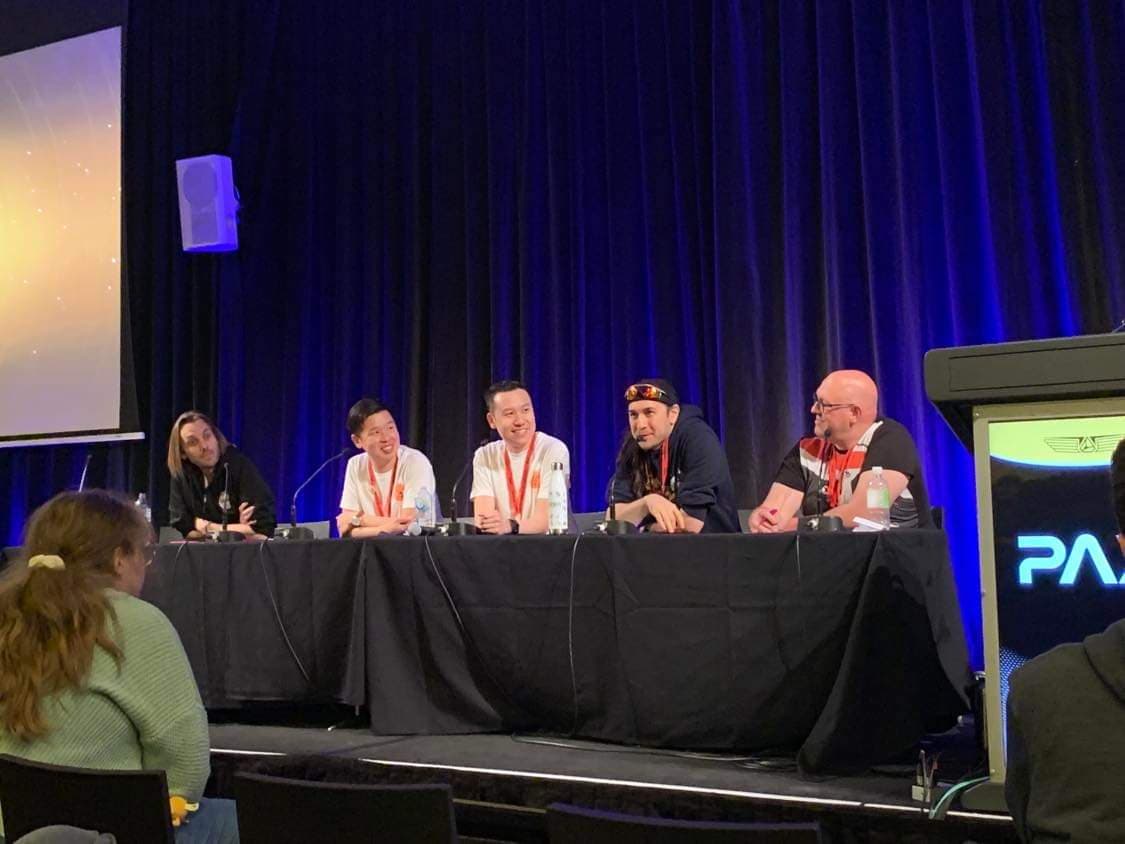This is part five in a series breaking down our process as first-time exhibitors at PAX. This section addresses what didn’t go so well.
What didn’t work
The demo took longer than expected:
We thought we could run a demo every 45 minutes – 20-30 minutes for the game, and 10 minutes for re-setting the table and debrief/feedback, plus a water break. Instead it was taking 20-40 minutes depending on the group, and resetting alone took almost 10 minutes, so we swapped to hourly demo games which worked better.
We ran a normal battle, a mini-boss battle, two story cards, and a boss battle. One option would be to take out the earlier battles and jump straight to the boss battle. This would work great for some players, but for others it would cause real confusion.
I don’t know what the solution is here, but I would advise that you test out your demo as much as possible beforehand to gauge your timeframe accurately.
Three staff members wasn’t enough:
I don’t think we could have known this in advance. If we hadn’t been very successful, three would have been plenty to have allowed shift rotation so that everyone could explore PAX and see something. As it was, we had almost non-stop playthroughs, and a line of visitors that was frequently eight people deep.
If we were in this situation again, we would probably find a last-minute promo group on Facebook and arrange an additional staff member. It would have cost a bit extra but we could probably have signed up a few extra emails, shifted a bit more of our merchandise, and taken the pressure off everyone including our visitors.
Improved organisation:
Our organisation wasn’t bad, but having done it once there are a few points that could have been improved. For one thing, our merch board should have been visible from the prize wheel. That way people could immediately see what they had won rather than asking us – especially as some of the prizes required a choice. Our prizes could also have been easier to search through.
And finally, on the email sign-up sheet, next time I would write “USE CAPITAL LETTERS” halfway down the page. We had written it at the top but nobody read it, and it was a real struggle to read messy handwriting when inputting that data.
We didn’t drink enough water:
We had meant to supply our table with a few bottles of drinking water, above the reusable bottle we each brought in our backpacks daily. With such a crowd, it was really hard to find any time to take breaks (Chris didn’t take any over three days, and I only got about 35 minutes of break on Friday, then none), so refilling water bottles just didn’t happen. That said, with so many people, it was hard to find time even to drink the water, so that was a problem too.
Suffice to say, by the end of each day we were both badly dehydrated – and very hungry. This was stupid and I very much wouldn’t recommend doing it. Our patch solution was hydralite at our accommodation each evening – treat yourself like you’re about to have a hangover.
Vocal warm-ups would have been good:
I would estimate that over the course of the weekend, I alone spoke to about 3000 unique visitors. I was wearing a mask, and the room was loud, so by the end of Sunday I had completely lost my voice, and it stayed more-or-less lost for the next two days. It’s not a big deal, I’m not a professional singer or anything, but that is damage on the body. I don’t know if people do this at conventions, but next time I would be looking for some vocal warm-ups.
We got to see almost nothing:
Literally the only part of PAX I saw aside from bump-in and bump-out and our own booth was a comedy show on the Saturday night. That was great! (The Dark Room, if you get the chance.)
But hey – victims of our own success on this one, and not really a complaint. This is just part of the thrill of a start-up company. As interesting as PAX seemed to be, the place I most wanted to be was right there at the Aethermon booth, building my own future.
Media??
When prepping for our PAX, we read a few other people’s experiences of running a booth at USA PAX events (very helpful, by the way, thank you to those writers). Most of these referenced reaching out to media in advance of PAX to start a conversation, get you on people’s radar, and possibly create some media coverage. PAX after all is only a few-days event – once it’s over your opportunity to make an impression is over with it. But if someone has written an interview or an article about you, potential customers might discover that days, weeks or months later.
I don’t know if this is a problem of the Australian game scene being smaller than the USA market, or that tabletop games just don’t command the same interest as video games, or whether we just didn’t do enough research, but one way or another, I had absolutely no idea who we could reach out to in advance of this event, and as a result, nobody came to talk to us during media hour, and very few during other hours too.
If there was a list of media attending the event we could have searched which of those people would be most interested for us to approach them, but we didn’t get anything like that. Now that PAX is over and we have some more time to think, we realised that we could have reached out to a Facebook group like “Board games reviewers & media” – next time, I suppose.
Emails:
In anticipation of growing our mailing list, we had recently switched from the services of MailChimp to SendInBlue. The subscription we have allows for a certain number of emails to be sent out in any given hour. Under normal circumstances this would be no problem for us, but we had forgotten to factor in PAX and should have temporarily upped our subscription fee to SendInBlue during the convention days, because after about 11am each day, people weren’t receiving a confirmation email when they signed up to our mailing list – there was too much backlog. Oops.
PAX panels:
When we won our place on the Indie Showcase, the fine people of PAX also asked whether we would like to speak on a panel with the other indie designers. Or rather, they asked if Chris would like to speak. There was no offer extended to me as co-creator.
As the hour of the panel drew near, Chris headed off and I ‘closed up’ our booth for the evening. Having done, I went to hear the panel, arriving a few minutes late. I walk in to see Chris and our fellow winners at the panel – including both co-creators of the booth diagonal to us!
Turns out, they too didn’t get more than one offer to speak, and sent numerous emails requesting this with no response (thanks PAX?!), but they made the wise decision just to try it anyway, and so both of them walked right up there and were not turned away.
In the grand scheme, it’s not a big deal, but I can’t help wishing I had done the same, and just turned up as if I belonged there. Lesson learned, but at the same time, in future I hope PAX reconsiders the way it makes these offers – especially if they’re serious about increasing diversity in the gamesphere. When you’re already wondering whether you belong in this industry, and then this happens, it’s hard to summon the confidence to push back.
Things to note:
- Double-check the timing of your demo.
- Maximum organisation, adapt to staffing needs if possible.
- Take care of your needs – water, food, breaks.
- Make yourself known to media in advance if you can.
- Panel? Yes.

